Download Electric Charge Field , In this post We will Study, Electric charge and fields Notes & Important Topic for Student to excel in exam.
NCERT/CBSE class 12th Physics notes provided by free-education.in (Wisdom Education Academy).
Here We are providing all subject wise pdf notes to student for their help to get good marks in exam.
In this post you will get Download CBSE 2020-21 Physics PDF notes given below by free-education.in to excel in the exam.
www.free-education.in is a platform where you can get pdf notes from 6th to 12th class notes, General Knowledge post, Engineering post, Career Guidelines , English Speaking Trick , How to crack interview and lots more.
Chapter 1: Electric Charges Fields pdf notes download
Here in this post we have made notes on most important topic of first chapter of Physics (Electric Charge and Field)
However Let’s find out Here, what are important topic of Electric Charge and Field for student to excel in exam.
Electric Charge
Electric charge is the physical property of matter that causes it to experience a force when placed in an electromagnetic field.
- Electromagnetism is the phenomenon of the interaction of electric currents or fields and magnetic fields.
- When insulating surfaces are rubbed against each other, a static charge is developed which gets discharged after getting in contact with a conductor.
- Only one of the two charges(or polarity) gets developed on rubbing – either positive or negative. An object becomes positively charged when it loses the loosely bound electrons to another object while rubbing. The other object gains electrons and becomes negatively charged.
- When like charges are brought near, they repel each other. Unlike charges attract each other.
- The charges get neutralized when the two bodies are brought in contact.
- An example of electric charge generation through rubbing of glass rod with silk and plastic rod with silk is mentioned below:
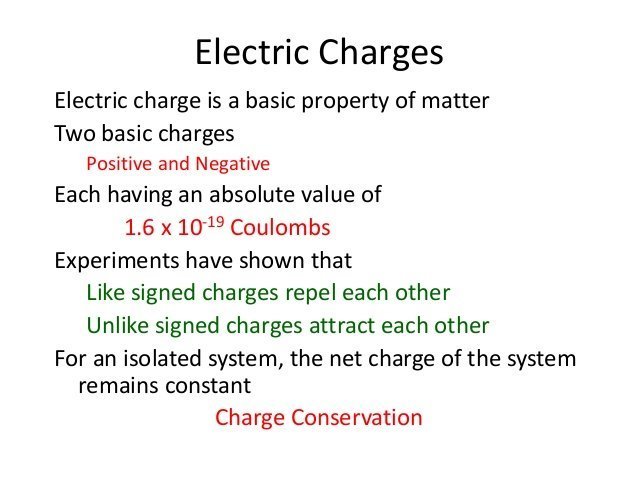

Conductors and Insulators
| Criteria | Conductors | Insulators |
| Definition | Substances which allow electricity to pass through them are called conductors. | Substances which do not allow electricity to pass through them are called insulators. |
| Electron Movement | Free movement | None or very low |
| Charge transfer | Charge gets distributed over whole body once it is transferred to a conductor. | Charge stays at one place when transferred to an insulator. |
| Examples | Human body, Metals, water | Plastic, wood, glass |
- Semiconductors offer resistance to movement of charges which is between conductors and non-conductors.
- The process where excess charge from a body or object goes to ground, by touching the charge carrying conducting body to earth is called earthing or grounding.
Charging By Contact:-
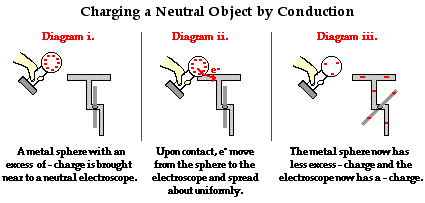

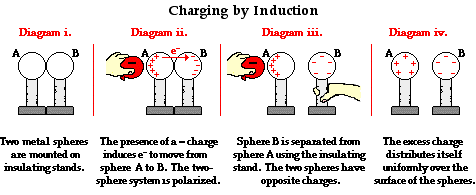
Properties of electric charge
Electric charge for a body is considered as Point charges if their size is very small in comparison to the distance between them. So the charge is considered to be concentrated at one point. Following are the properties of electric charge in terms of point charges:
- Additivity of charges:
- Point charges are scalars and can be added algebraically. If q1, q2, q3, … qn, are point charges, the total charge qtot=q1+ q2 + q3+ qn
- Charges have no direction but can be positive or negative.
- Conservation of charges:
- Total charge in an isolated system is always conserved. When there are many bodies in an isolated system, the charges get transferred from one body to another but the net charge of the system remains same.
- During rubbing or natural forces, no new charge is created. The charges are either redistributed or a neutron breaks up into proton and electron of equal and opposite charge.
- Quantization of charges:
- The charge is always represented in the form of, q = ne. Here n is an integer and e is the charge (- for electron and + for proton). Magnitude of e = 1.602192 X 10-19 This is called quantization of charge.
- SI unit of charge is Coulomb (C).
- Quantization is usually ignored at macroscopic levels (μC) because at that point, charges are taken to be continuous.
Coulomb’s Law
Coulomb’s law states that Force exerted between two point charges:
- Is inversely proportional to square of the distance between these charges and
- Is directly proportional to product of magnitude of the two charges
- Acts along the line joining the two point charges.
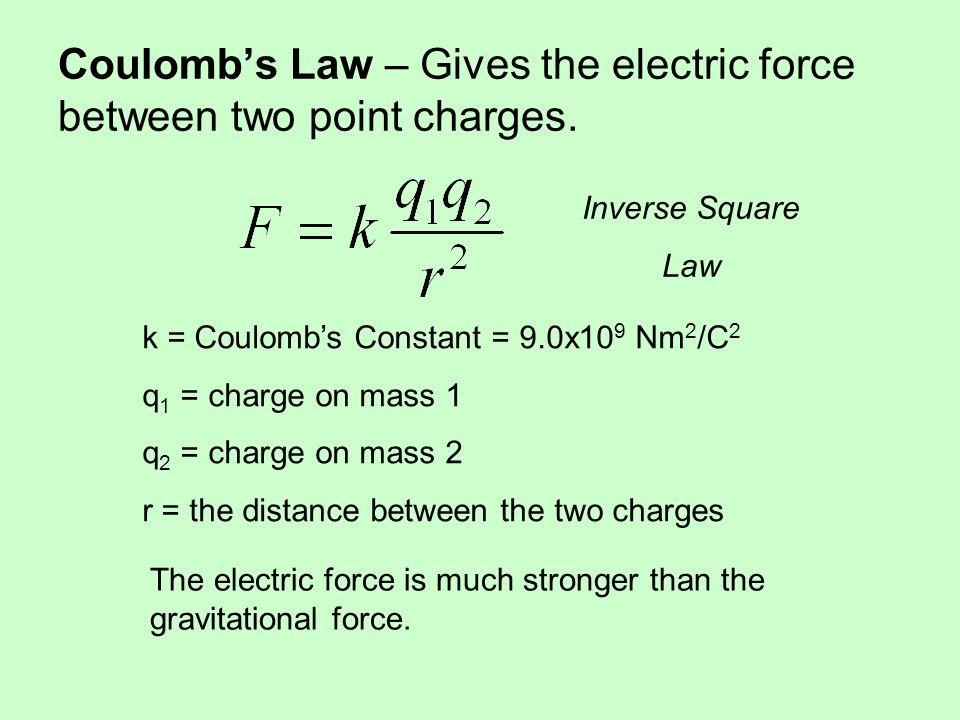
Forces between multiple charges –Superposition principle
As per the principle of superposition, the force on any charge due to a number of other charges is the vector sum of all the forces on that charge due to other charges, taken one at a time.

Electric Field
Electric field is a force produced by a charge near its surroundings. This force is exerted on other charges when brought in the vicinity of this field.
- SI unit of electric field is N/C (Force/Charge).
- Electric field due to a charge at a point is the force that a unit positive charge would experience if placed at that point.
- The charge generating electric field is called source charge and the charge which experiences this field is called test charge. Practically, to keep source charge undisturbed due to the electric field of test charge, the test charge is kept infinitely small.
- Since F(Force) is proportional to q (Charge), the electric field is independent of q but depends on r (space coordinates).
- The electric field is symmetric in spherical coordinates.
- The concept of Electric field is used to account for the time delay for a charged body to experience force from the field of a source charge.
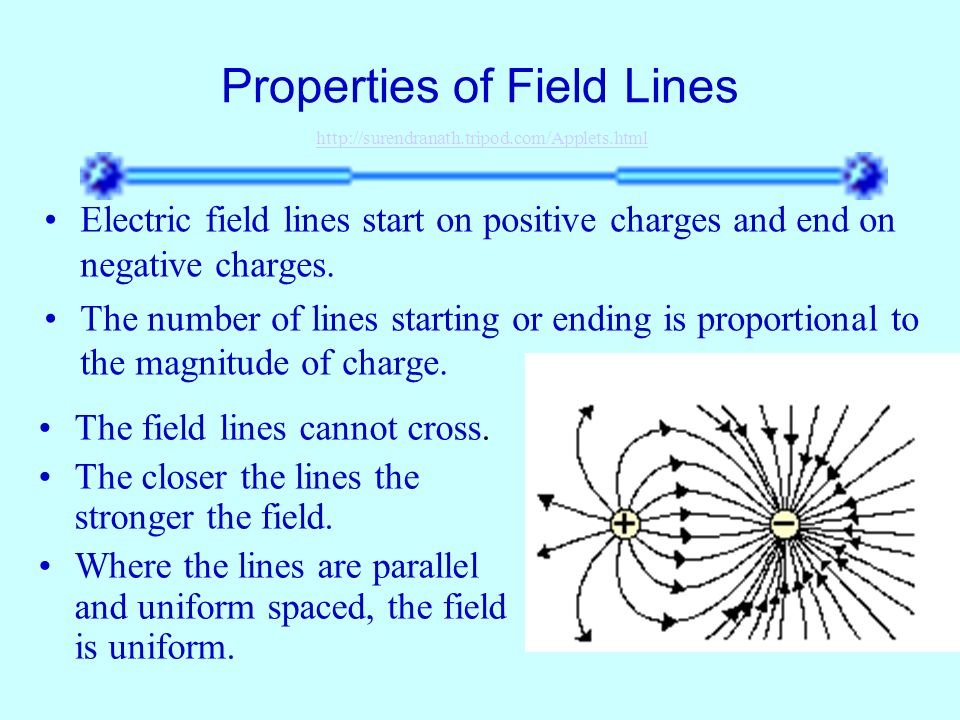

Electric Flux
Electric flux is the measure of flow of the electric field through a given area. Electric flux is proportional to the number of electric field lines going through a normally perpendicular surface.
- The orientation of area element decides the amount of electric flux. Thus, the area element is a vector.
- The vector associated with every area element of a closed surface is taken to be in the direction of the outward normal.
- Area element vector ΔS = ΔSn̂, ΔS is magnitude of area element and n̂ is unit vectorin the direction of outward normal.
- Electric flux, Δφ = EΔS = E ΔScosθ, θ is angle between E and ΔS.
- Unit of electric flux is NC-1m2.
- Total flux through a surface, φ ≈ Σ EΔS


Electric Dipole
An electric dipole is a pair of equal and opposite point charges q and –q, separated by a distance of 2a.
- Direction from –q to q is the direction of the dipole.
- The mid-point of locations of –q and q is called the center of the dipole.
- Total charge of an electric dipole is zero but since the charges are separated by some distance the electric field do not cancel out.
- Dipole moment is the mathematical product of the separation of the ends of a dipole and the magnitude of the charges (2a x q).
- Some molecules like H2O, have permanent dipole moment as their charges do not coincide. These molecules are called polar molecules.
- Permanent dipoles have a dipole moment irrespective of any external Electric field.
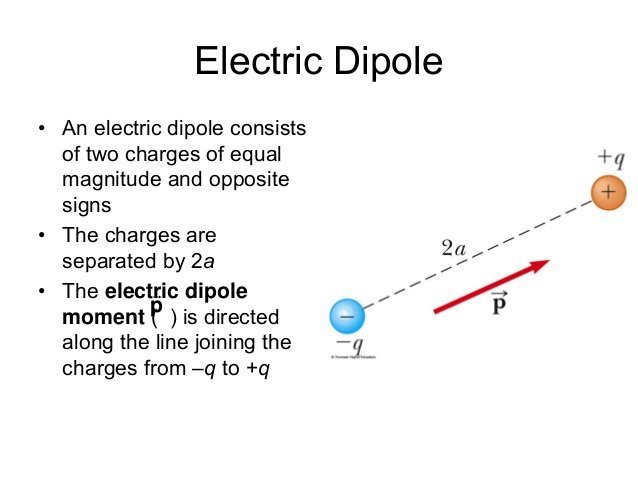
Electric field of an electric dipole
Electric field of an electric dipole at a point in space depends upon the position of the point.
- The dipole field at a point is inversely proportional to the cube of distance from the center to the point.
- For a very small dipole, the 2a approaches zero. This is called point dipole.
Dipole in a uniform electric field
When two charges in a dipole are separated by some distance, the forces acting at different points result in torque on the dipole.
The torque tries to align the dipole with electric field. Once aligned, the torque becomes 0.
- Magnitude of torque = qE x 2a sinθ = 2qaE sinθ = pEsinθ.
- Direction of the torque= normal to the plane coming outwards.

Continuous Charge Distribution
| Type of charge distribution | Denoted by | Value | Unit |
| Line Charge | λ (Line charge density) | ΔQ/Δl, Δl is small line element of wire that contains microscopic charged constituents and ΔQ is charge contained in the line element. | C/m |
| Surface Charge | σ (surface charge density) | ΔQ/ΔS, ΔSis an area element on the surface of a conductor and ΔQ is charge on that element. | C/m2 |
| Volume Charge | ρ (volume charge density) | ΔQ/ΔV, ΔV is a volume element which includes a large number of microscopically charged constituents and ΔQ is charge on that element. | C/m3 |
Gauss’s Law
According to Gauss’s law, the total of the electric flux out of a closed surface is equal to the charge enclosed divided by the permittivity. The total electric flux through a closed surface is zero if no charge is enclosed by the surface.
- Gauss’s law is true for any closed surface, no matter what its shape or size.
- The term q on the right side of Gauss’s lawincludes the sum of all charges enclosed by the surface. The charges may be located anywhere inside the surface.
- In the situation when the surface is so chosen that there are some charges inside and some outside, the electric field [whose flux appears on the left side of Eq. (1.31)] is due to all the charges, both inside and outside S. The term q on the right side of Gauss’s law, however, represents only the total charge inside S.
- The surface that we choose for the application of Gauss’s law is called the Gaussian surface. The Gaussian surface can pass through a continuous charge distribution.
- Gauss’s law is useful for the calculation of the electrostatic field for a symmetric system.
- Gauss’s law is based on the inverse square dependence on distance contained in the Coulomb’s law. Any violation of Gauss’s law will indicate departure from the inverse square law.
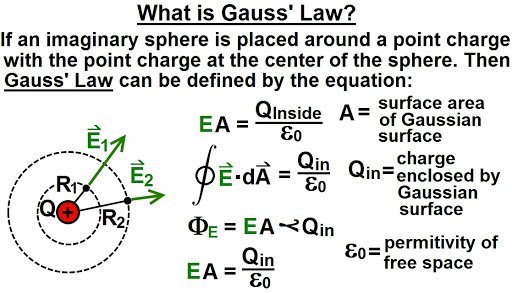
Applications of Gauss’s Law
Field due to infinitely long straight uniformly charged wire
Field due to a uniformly charged infinitely plane sheet
Field due to a uniformly charged thin spherical shell

Mohd. Sharif Qualification: B.Tech (Mechanical Engineering) [Founder of Wisdom Academy] [Aim Foundation & Free-Education.In] [Engineer By Profession | Teacher By Choice] [Blogger, YouTube Creator]






